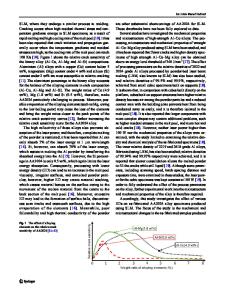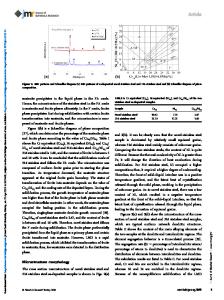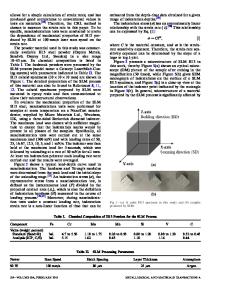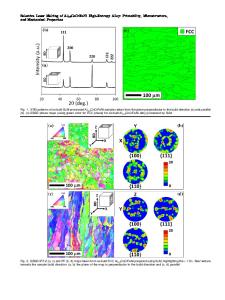Microstructure and Mechanical Properties of 316L Stainless Steel Fabricated Using Selective Laser Melting
- PDF / 754,971 Bytes
- 9 Pages / 432 x 648 pts Page_size
- 76 Downloads / 371 Views
MRS Advances © 2019 Materials Research Society DOI: 10.1557/adv.2019.251
Microstructure and Mechanical Properties of 316L Stainless Steel Fabricated Using Selective Laser Melting N. Iqbal1, E. Jimenez-Melero2, U. Ankalkhope3, and J. Lawrence1 1
Institute for Advanced Manufacturing and Engineering, University of Coventry, CV6 5LZ, UK
2
Materials Performance Centre, School of Materials, University of Manchester, M13 9PL, UK
3
Manufacturing Technology Centre, Ansty Park, Coventry, CV7 9JU, UK
ABSTRACT
The microstructure homogeneity and variability in mechanical properties of 316L stainless steel components fabricated using selective laser melting (SLM) have been investigated. The crack free, 99.9% dense samples were made starting from SS316L alloy powder, and the melt pool morphology was analysed using optical and scanning electron microscopy. Extremely fast cooling rates after laser melting/solidification process, accompanied by slow diffusion of alloying elements, produced characteristic microstructures with colonies of cellular substructure inside grains, grown along the direction of the principal thermal gradient during laser scanning. In some areas of the microstructure, a significant number of precipitates were observed inside grains and at grain boundaries. Micro hardness measurements along the build direction revealed slight but gradual increase in hardness along the sample height. Uniaxial tensile tests of as manufactured samples showed the effect of un-melted areas causing scatter in room-temperature mechanical properties of samples extracted from the same SLM build. The ultimate tensile strength (UTS) varied from 458MPa to 509MPa along with a variation in uniform elongation from 3.3% to 14.4%. The UTS of a sample exposed to o the Cl- rich corrosion environment at 46 C temperature revealed a similar strength as of the original sample, indicating good corrosion resistance of SLM samples under those corrosion conditions.
2431
Downloaded from https://www.cambridge.org/core. University of Cincinnati Libraries, on 18 Nov 2019 at 16:05:01, subject to the Cambridge Core terms of use, available at https://www.cambridge.org/core/terms. https://doi.org/10.1557/adv.2019.251
INTRODUCTION: Selective Laser Melting (SLM) is an attractive additive manufacturing technique, receiving growing attention to produce 3D components with complex inner structures, in a single-step building process [1, 2]. The process is based on the local melting of a pre-mixed metal alloy powder using a high power laser beam and layer-bylayer manufacturing of components, based on computer-aided design models. The technology offers the opportunity to manufacture components with unusual microstructures and properties due to multiple laser scan strategies and non-equilibrium solidification. It has been employed for materials across the board, from metals to polymers, ceramics to composites, and even more complex engineered materials [3-5]. The SS316L steel is among the widely used structural material due to combination of good mechanical pr
Data Loading...











